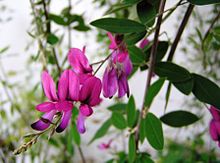Lespedeza
| Lespedeza | |
|---|---|
 |
|
| Inflorescence and foliage of L. thunbergii | |
| Scientific classification | |
| Kingdom: | Plantae |
| (unranked): | Angiosperms |
| (unranked): | Eudicots |
| (unranked): | Rosids |
| Order: | Fabales |
| Family: | Fabaceae |
| Subfamily: | Faboideae |
| Tribe: | Desmodieae |
| Subtribe: | Lespedezinae |
| Genus: |
Lespedeza Michx. |
| Species | |
|
about 40, see text |
|
| Synonyms | |
|
|
about 40, see text
Lespedeza is a genus of some 40 species (including nothospecies) of flowering plants in the pea family (Fabaceae), commonly known as bush clovers or (particularly East Asian species) Japanese clovers (hagi). The genus is native to warm temperate to subtropical regions of eastern North America, eastern and southern Asia and Australasia.
These shrubby plants or trailing vines belong to the "typical" legumes (Faboideae), with the peas and beans, though they are part of another tribe, the Desmodieae. Therein, they are treated as type genus of the smaller subtribe Lespedezinae, which unites the present genus and its presumed closest relatives, Campylotropis and Kummerowia.
According to American botanist Asa Gray (1810 – 1888), the Lespedeza owes its name to governor of East Florida Vicente Manuel de Céspedes (1784-1790; who, through a letter, allowed to botanist André Michaux explore the East Florida in search of new species of plants, finding there to the Lespedeza), but when Céspedes wrote the letter, at the beginning of it, the name of Céspedes was changed to "Zespedez". So, when the Michaux´s book Flora Boreali-Americana of 1802 was printed, the name "Céspedes" to refer to the plant was written as "Lespedez", word of which derived the current name of the plant.
...
Wikipedia
